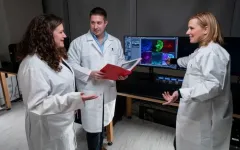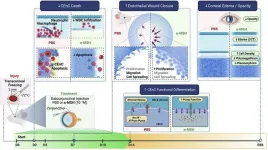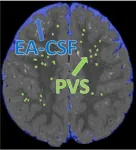(Press-News.org) St. Jude Children’s Research Hospital scientists found that cytonemes (thin, long, hair-like projections on cells) are important during neural development. Cytonemes connect cells communicating across vast distances but are difficult to capture with microscopy in developing vertebrate tissues. The researchers are the first to find a way to visualize how cytonemes transport signaling molecules during mammalian nervous system development. The findings were published in Cell.
“We showed cytonemes are a direct express route for signal transport,” said corresponding author Stacey Ogden, PhD, St. Jude Department of Cell and Molecular Biology. “Cells need to communicate with each other during development and tissue homeostasis and be able to reach more than just their neighbors. We’ve identified one way that signals are loaded into cytonemes for transport to responding cell populations and demonstrated that tissue patterning does not happen properly when this mode of signal dispersion is compromised.”
Express signal delivery sets up the nervous system for success
Researchers in Ogden’s lab were the first to visualize mammalian cytonemes in the developing nervous system by combining modern microscopy techniques with optimized sample preparations.
“For a long time, visualizing these structures in developing mammalian tissue has been challenging,” Ogden said. “But we’ve finally found a way.”
Using their new methods, the scientists captured images of how cytonemes act as an “express” system that can skip over intervening cells to directly deliver signals to more distant ones, similar to an express subway that only stops at major stations. One of the major stations is the notochord, which produces a signal that plays a crucial role in organizing the developing spinal cord. Ogden’s team captured images of the transport process happening in the cytonemes originating from the notochord.
When the researchers prevented signaling proteins from entering cytonemes, neural development was disrupted in mouse models, causing major neurological defects.
“This is the first demonstration of these cytoneme-based transport processes occurring during the development of a complex mammalian tissue such as the neural tube,” Ogden said. “Then we showed that when we reduce cytoneme numbers or decrease the ability of cells to load signaling proteins into these structures, we get developmental defects.”
Cytoneme transport helps establish the gradient
Mammalian development is a carefully guided process that must be coordinated for all organs and tissues to form correctly. One way cells know when to adopt a specific fate is by responding to distinct thresholds of signaling proteins called morphogens. Cells will respond differently to these signals across a signaling gradient, taking on different characteristics in response to high and low concentrations of a particular morphogen. A good gradient is necessary for development; a bad gradient can spell disaster.
Despite their importance, how these patterns of morphogens are created across fields of organizing cells has remained a mystery. Simple diffusion can explain some, but not all, of these gradients. The neurological deficits created when the scientists blocked signals from entering cytonemes provide evidence that supports a key role for cytoneme signaling during morphogen patterning.
“These deficits are really the first direct evidence that cytoneme-based signaling plays a key role during neural tube patterning,” Ogden said.
Transporting ‘sonic hedgehog’ through cytonemes
The St. Jude group clarified one way that a gradient of the sonic hedgehog morphogen is formed in the neural tube. Sonic hedgehog was already known as a critical signaling molecule in neural development, but its route to reach its target cells has been difficult to ascertain. The study identified cytonemes as key contributors to a solution that creates the sonic hedgehog signaling gradient. Correspondingly, when sonic hedgehog could not be loaded in cytonemes, its signaling function was compromised.
“In the morphogen signaling research field, we’ve always wanted to know how a signal gets from one population of cells to spread across a receiving cell population to make a gradient,” Odgen said. “It’s really exciting to show that cells that are producing morphogen signals are playing an active role in getting them to where they need to go through cytonemes. The signaling cell is not only making the morphogen, but it’s also helping to physically deliver the signal.”
What remains unclear is how widespread cytoneme express transport of signaling proteins is in development.
“Here, we’ve used sonic hedgehog as a model,” Ogden said. “But we also have evidence that these structures may be important for transporting other signals that are crucial during neural tube development. Now that we’ve developed a system to visualize these cytonemes, we can begin to uncover the true breadth of their function.”
Authors and funding
The study’s first author is Eric Hall of St. Jude. The study’s other authors are Miriam Dillard, Elizabeth Cleverdon, Yan Zhang, Christina Daly, Shariq Ansari, Randall Wakefield, Daniel Stewart, Shondra Pruett-Miller, Alfonso Lavado, Alex Carisey, Amanda Johnson, Yong-Dong Wang, Emma Selner, Michael Tanes, Young Sang Ryu, Camenzind Robinson and Jeffrey Steinberg, all of St. Jude.
The study was supported by grants from the National Institutes of Health (R35GM122546 and F31HD110256), National Cancer Institute (P30CA021765 St. Jude Cancer Center Support Grant) and ALSAC, the fundraising and awareness organization of St. Jude.
END
Elusive cytonemes guide neural development, provide signaling ‘express route’
Scientists at St. Jude Children’s Research Hospital imaged cellular projections called cytonemes that transfer signals across long distances during development
2024-01-02
ELSE PRESS RELEASES FROM THIS DATE:
Pioneering study indicates a potential treatment for corneal endothelial disease, reducing the need for corneal transplants
2024-01-02
Philadelphia, January 2, 2024 – Findings from a pioneering study in The American Journal of Pathology, published by Elsevier, reveal that administration of the neuropeptide α-melanocyte–stimulating hormone (α-MSH) promotes corneal healing and restores normal eye function to an otherwise degenerating and diseased cornea by providing protection against cell death and promoting cell regeneration.
Due to a lack of currently available medical therapy, patients suffering from corneal endothelial disease, ...
Diversity of bioluminescent beetles in Brazilian savanna has declined sharply in 30 years
2024-01-02
At night in the Cerrado, Brazil’s savanna and second-largest biome, larvae of the click beetle Pyrearinus termitilluminans, which live in termite mounds, display green lanterns to capture prey attracted by the bright light.
In more than 30 years of expeditions with his students to Emas National Park and farms around the conservation unit in Goiás state to collect specimens, the phenomenon has never been so rare, said Vadim Viviani, a professor at the Federal University of São Carlos’s Science and Technology for Sustainability Center (CCTS-UFSCar) in Sorocaba, São Paulo state.
“In the 1990s, we ...
Binghamton University professor and Nobel Laureate Stanley Whittingham wins 2023 VinFuture Grand Prize
2024-01-02
Binghamton University, State University of New York Distinguished Professor and Nobel Laureate M. Stanley Whittingham has been chosen as the joint winner of the $3 million 2023 VinFuture Grand Prize in recognition of his contributions to the invention of lithium-ion batteries. The prize recognized how the combination of solar energy and lithium battery storage is overcoming climate change and was recently presented by the Prime Minister of Vietnam.
“I am truly honored to be chosen for this prestigious honor,” said Whittingham. “VinFuture’s efforts to recognize green and sustainable energy is a noble cause, and ...
Deciphering molecular mysteries: new insights into metabolites that control aging and disease
2024-01-02
ITHACA, NY: In a significant advancement in the field of biochemistry, scientists at the Boyce Thompson Institute (BTI) and Cornell University have uncovered new insights into a family of metabolites, acylspermidines, that could change how we understand aging and fight diseases.
The study, recently published in Nature Chemical Biology, presents an unexpected connection between spermidine, a long-known compound present in all living cells, and sirtuins, an enzyme family that regulates many life-essential functions.
Sirtuins ...
Women’s and girls’ sports: more popular than you may think
2024-01-02
COLUMBUS, Ohio – The number of Americans who watch or follow girls’ and women’s sports goes well beyond those who view TV coverage of women’s athletic events, a new study suggests.
In fact, just over half of American adults spent some time watching or following female sports in the past year, the results showed.
U.S. adults spend about one hour a week consuming female sports content, which may seem higher than expected, according to the researchers. Still, it is only a small fraction of Americans’ overall sports consumption.
The study was ...
Calcium channel blockers key to reversing myotonic dystrophy muscle weakness, study finds
2024-01-02
New research has identified the specific biological mechanism behind the muscle dysfunction found in myotonic dystrophy type 1 (DM1) and further shows that calcium channel blockers can reverse these symptoms in animal models of the disease. The researchers believe this class of drugs, widely used to treat a number of cardiovascular diseases, hold promise as a future treatment for DM1.
“The main finding of our study is that combined calcium and chloride channelopathy is highly deleterious and plays a central role in the function impairment of muscle found in the disease,” said John Lueck, Ph.D., an assistant professor at the University of Rochester Medical Center (URMC) in the Departments ...
Enlarged spaces in infant brains linked to higher risk of autism, sleep problems
2024-01-02
Throughout the day and night, cerebrospinal fluid (CSF) pulses through small fluid-filled channels surrounding blood vessels in the brain, called perivascular spaces, to flush out neuroinflammation and other neurological waste. A disruption to this vital process can lead to neurological dysfunction, cognitive decline, or developmental delays.
For the first time, researchers Dea Garic, PhD, and Mark Shen, PhD, both at the UNC School of Medicine’s Department of Psychiatry, discovered that infants with abnormally enlarged perivascular spaces have a 2.2 times greater chance of developing autism ...
Growth hormone influences regulation of anxiety via a specific group of neurons
2024-01-02
Growth hormone (GH) acts on many tissues throughout the body, helping build bones and muscles, among other functions. It is also a powerful anxiolytic. A study conducted by researchers at the University of São Paulo (USP) in Brazil has produced a deeper understanding of the role of GH in mitigating anxiety and, for the first time, identified the population of neurons responsible for modulating the influence of GH on the development of neuropsychiatric disorders involving anxiety, depression and post-traumatic stress. An article on the study is published in the Journal of Neuroscience.
In ...
Influencers’ vulnerabilities: a double-edged sword
2024-01-02
ITHACA, N.Y. – New Cornell University-led research finds that social media platforms and the metrics that reward content creators for revealing their innermost selves to fans open creators up to identity-based harassment.
“Creators share deeply personal – often vulnerable – elements of their lives with followers and the wider public,” said Brooke Erin Duffy, associate professor of communication. “Such disclosures are a key way that influencers build intimacy with audiences and form communities. There’s a pervasive sense that internet users clamor for less polished, less idealized, ...
Designing the ‘perfect’ meal to feed long-term space travelers
2024-01-02
Imagine blasting off on a multiyear voyage to Mars, fueled by a diet of bland, prepackaged meals. As space agencies plan for longer missions, they’re grappling with the challenge of how to best feed people. Now, researchers reporting in ACS Food Science & Technology have designed the optimal “space meal”: a tasty vegetarian salad. They chose fresh ingredients that meet male astronauts’ specialized nutritional needs and can be grown in space.
Astronauts in space burn ...
LAST 30 PRESS RELEASES:
Numbers in our sights affect how we perceive space
SIMJ announces global collaborative book project in commemoration of its 75th anniversary
Air pollution exposure and birth weight
Obstructive sleep apnea risk and mental health conditions among older adults
How talking slows eye movements behind the wheel
The Ceramic Society of Japan’s Oxoate Ceramics Research Association launches new international book project
Heart-brain connection: international study reveals the role of the vagus nerve in keeping the heart young
Researchers identify Rb1 as a predictive biomarker for a new therapeutic strategy in some breast cancers
Survey reveals ethical gaps slowing AI adoption in pediatric surgery
Stimulant ADHD medications work differently than thought
AI overestimates how smart people are, according to HSE economists
HSE researchers create genome-wide map of quadruplexes
Scientists boost cell "powerhouses" to burn more calories
Automatic label checking: The missing step in making reliable medical AI
Low daily alcohol intake linked to 50% heightened mouth cancer risk in India
American Meteorological Society announces Rick Spinrad as 2026 President-Elect
Biomass-based carbon capture spotlighted in newly released global climate webinar recording
Illuminating invisible nano pollutants: advanced bioimaging tracks the full journey of emerging nanoscale contaminants in living systems
How does age affect recovery from spinal cord injury?
Novel AI tool offers prognosis for patients with head and neck cancer
Fathers’ microplastic exposure tied to their children’s metabolic problems
Research validates laboratory model for studying high-grade serous ovarian cancer
SIR 2026 delivers transformative breakthroughs in minimally invasive medicine to improve patient care
Stem Cell Reports most downloaded papers of 2025 highlight the breadth and impact of stem cell research
Oxford-led study estimates NHS spends around 3% of its primary and secondary care budget on the health impacts of heat and cold in England
A researcher’s long quest leads to a smart composite breakthrough
Urban wild bees act as “microbial sensors” of city health.
New study finds where you live affects recovery after a hip fracture
Forecasting the impact of fully automated vehicle adoption on US road traffic injuries
Alcohol-related hospitalizations from 2016 to 2022
[Press-News.org] Elusive cytonemes guide neural development, provide signaling ‘express route’Scientists at St. Jude Children’s Research Hospital imaged cellular projections called cytonemes that transfer signals across long distances during development





